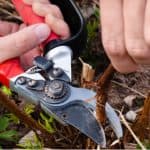Last updated on March 27th, 2022
Our site is reader supported, this means we may earn a small commission from Amazon and other affiliates when you buy through links on our site.
Having fresh growing raspberries makes any summer or autumn recipe even better, plus they taste great picked straight from the bush. Buying raspberries in the supermarket can be expensive, especially if they are out of season in your area. It will be much more advantageous to simply grow raspberries yourself so that you can cultivate the fruit all season long and have it at the ready to toss on your breakfast granola, add to a dessert, or simply eat as they come. They make great fruit for children to grow too.
When to plant raspberries
Raspberries should be planted in thawed soil, ideally, sometime between November and March, and are usually sold bare rooted at this time of year so are much cheaper to buy. They tend to fruit between June and October depending on the variety and whether they are summer or autumn fruiting. You can plant bare root plants anytime between that November and March window as long as your soil isn’t yet frozen or waterlogged. This is going to vary based on where you live.
If you buy them from spring or through summer then you will be able to but them potted, sometimes even in fruit. This is fine but you will need to keep a close eye on the watering.
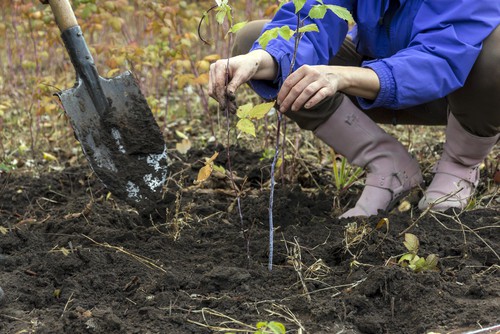
Which varieties are best?
Summer fruiting raspberries
The summer fruiting raspberry varieties produce fruit between June and August and some of the most common varieties for those of you who want early batches of fruit include ‘Glen Moy’ and ‘Glen Fyne’.
Autumn fruiting raspberries
If you want the autumn fruiting raspberries, they produce fruit between August and October. To have fruit the entire season you might want to consider purchasing both varieties. The autumn fruiting varieties don’t need any support structures so they are better for container growing and they are easier to prune. If you are a beginner you might want to start with this variety. The most common include ‘Autumn Bliss’, ‘Autumn Treasure’ and ‘All Gold’. The ‘All Gold’ variety produces yellow raspberries that are particularly unique.
Primocanes or floricanes?
Primocane varieties (fruit on the current year’s growth)
The next consideration is to choose between floricanes and primocanes. Primocane varieties of raspberries produce fruit and flowers on the stems which have been grown that year. Most of the autumn fruiting varieties are primocane varieties so you can get fruit the very first year you plant them and this is what makes pruning significantly easier because you simply lop all the canes down to ground level after they have finished fruiting.
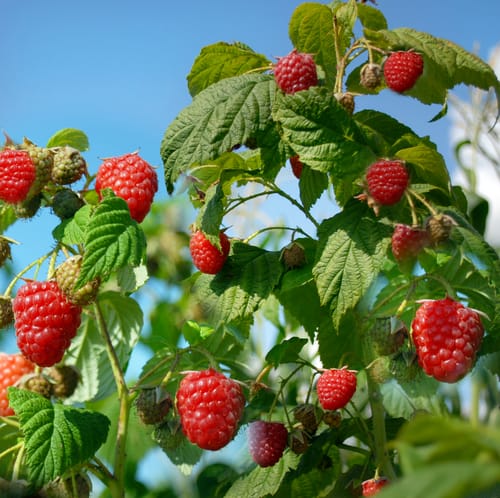
Floricane varieties (fruit on the previous year’s shoots)
By comparison, floricane raspberries produce fruit and flowers on stems that were grown one year prior. This means that you have to be a bit more cautious when pruning so that you don’t cut away the growth from the previous year that is instrumental to the production of fruit in the current year. Fruiting summer varieties tend to be floricane varieties.
Where to plant your raspberries
Raspberries prefer well-drained and fertile soil. They can be tolerant of some shade, but they will produce better flowers and subsequently better for fruit if they get sun. If you grow summer fruiting varieties you will need to provide a fence, frame, or wall against which they can grow. This should be around 1.5 metres. As mentioned, the autumn growing raspberries do not need a support structure.
Check out our detailed guide on how to prune raspberries in our guide by clicking here
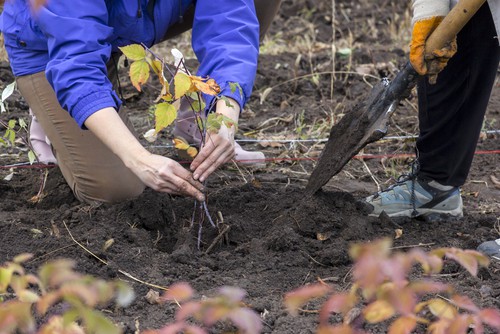
How to plant raspberries
Step 1
Once you have selected the appropriate spot in your garden, break up whatever soil you have with a garden fork and add some new compost, or well-rotted manure to add nutrients to the soil. Make sure that it’s mixed well into the soil that is already there.
Step 2
Add a row of posts with stretching wires between them. The posts should be about 1.5 metres (5ft) high and the wire should be about 60cm apart. You should leave about 1.8 metres (6ft) between each row.
Step 3
If you are planting the summer fruiting varieties, the canes should be planted 40cm apart and for the autumn fruiting varieties they should be 60cm apart. Place the canes 8cm deep into the ground and then gently pack them in with the remaining soil and compost. Once they are in place, water them well.
Newly planted canes should be cut down to about 25cm from the ground so that more shoots will develop.
Growing in containers
If you are growing in containers, make sure you pick something that is at least 60cm in diameter. Fill it with a soil-based compost such as John Innes potting compost so that it won’t dry out as quickly as the multi-purpose compost.
Plant the raspberries around the perimeter of the container and fill in the remaining space with soil. Water the plants well.
Don’t let the compost dry out and be sure to regularly water and feed with a high potash fertiliser while the plants are growing so that you can encourage more fruit. If you do grow in a container be advised that after about three years you should transplant your raspberries into the ground.
Caring for Raspberries
Feeding and watering raspberries
You want to make sure that you keep your raspberries in good condition so that they produce delightful fruit. To do this, feed them in the spring with growmore or fish blood and bone. Mulch around the base using well-rotted manure but be careful that you don’t accidentally bury the canes. This will help with moisture retention during any upcoming dry weather.
It’s equally important to water regularly during dry weather otherwise the fruit will suffer.
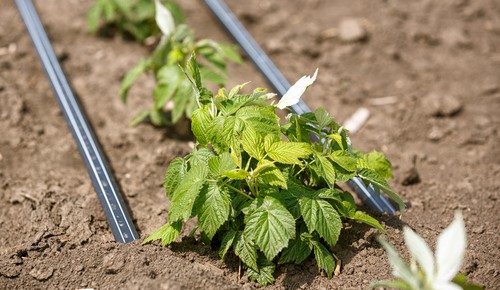
Dealing with suckers
Keep your eyes peeled for suckers. Raspberries produce suckers along with the root system so you might notice new canes popping up a bit of a distance away from your main plant. If you see these you can dig them up and pull them out as long as they are more than 22cm from the main plant. You won’t harm the main plant by severing these.
Protecting the fruit from birds
Once you start to see fruits on your plants it might be best to cover them with netting so that birds don’t eat the berries before you get a chance to eat the berries.
Pruning your raspberries
Pruning the raspberries is very important in terms of long-term maintenance. You will need a sharp pair of gardening secateurs as well as gardening gloves because some raspberry bushes such as ‘Autumn Bliss’ have thorns. You should sanitise the gardening secateurs so that you don’t accidentally transfer diseases from other plants in your garden.
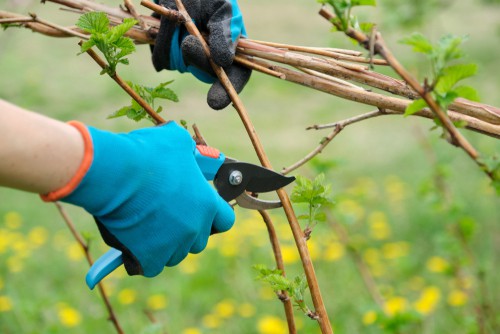
Pruning autumn fruiting raspberries
If you are growing the autumn fruiting raspberries you need to prune at the end of winter, usually around February. To do this you can cut back all of the growth to ground-level before any new growth manifests.
Pruning summer fruiting raspberries
If you are growing summer fruiting raspberries, at the beginning of autumn cut back the growth so that you have about eight, and all remaining branches down to ground level. It might do you some good to mark these with already produced fruit so that you can differentiate between which ones will produce fruit the following season. You only want to cut back the stems that produced fruit and leave the stems from that season that have yet to produce fruit. You want to aim to leave 8 stems from the current season that have not fruited and cut back the rest.
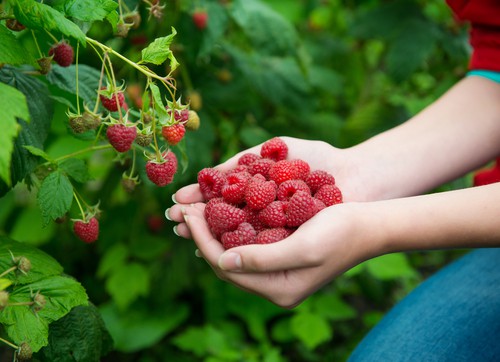
Harvesting raspberry berries
The last step in your process is knowing when to harvest the berries. You will know when it’s time to harvest your raspberries when you give them a gentle tug and the fruit falls off the plant easily. Once you harvest your raspberries, they won’t keep for very long so you should eat them immediately or place them in your freezer to save for later.
Freezing raspberries
If you plan to freeze your berries, the fruit should be placed on a flat tray (such as a baking tray or plastic tray) and left in the freezer for approximately one hour until the fruit itself is frozen. At that point, you can transfer all of the frozen fruit into separate bags. Because of the high water content, most fruits, if you toss them into a bag in their fresh form and then throw them in the freezer, they will stick together which can make it difficult to break apart later.
Overall following these steps will help you to grow raspberries successfully in the ground or in a container so that you can enjoy summer fruiting and autumn fruiting varieties.
Image credits – Shutterstock.com

